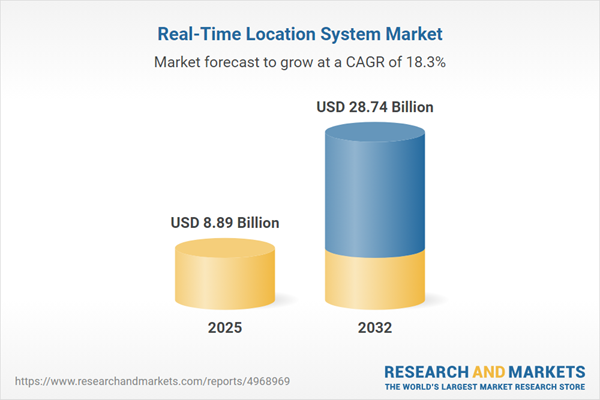Speak directly to the analyst to clarify any post sales queries you may have.
Real-time location systems are redefining how enterprises across key sectors manage, track, and optimize the flow of assets, inventory, and personnel. By offering precise, real-time insights, these solutions are transforming operational workflows and decision-making for senior leaders navigating digital transformation and supply chain efficiency.
Market Snapshot: Real-Time Location System Market Expansion
The Real-Time Location System Market grew from USD 7.49 billion in 2024 to USD 8.89 billion in 2025. It is expected to continue growing at a CAGR of 18.29%, reaching USD 28.74 billion by 2032. Market growth is driven by the increasing need for precision tracking, workflow optimization, and asset visibility across industry verticals. Organizations are adopting these solutions to meet the ongoing demands for transparency, efficiency, and agility in asset and workforce management.
Scope & Segmentation
- Application: Asset tracking (including fixed, medical, and returnable), inventory management (automated replenishment, real-time inventory), personnel tracking (staff, visitor), and process optimization (operational efficiency, workflow automation).
- Component: Hardware (antennas, readers, tags), services (consulting, deployment integration, support maintenance), and software (analytics, asset management, real-time location interfaces).
- End User Industry: Government defense, healthcare, logistics and warehousing, manufacturing, retail, and transportation.
- Technology: Bluetooth low energy, infrared, RFID, ultrasound, ultrawideband, Wi-Fi.
- Region: Americas (including North America and Latin America), Europe, Middle East & Africa (Europe, Middle East, Africa), and Asia-Pacific.
- Key Companies: Airista Flow, Essensium, General Electric, Honeywell International, Humatics, Midmark, Mojix, STMicroelectronics, Siemens, Zebra Technologies.
Key Takeaways for Senior Decision-Makers
- The primary keyword, real-time location system, denotes integrated platforms that empower organizations with actionable, granular insights for tactical and strategic gains.
- Market adoption is accelerating as digital transformation, traceability mandates, and the explosion of sensor-based infrastructure reshape expectations in sectors such as healthcare, manufacturing, logistics, and retail.
- Hybrid deployment models—combining on-premises resources with cloud-native technologies—are gaining traction, providing scalability and flexibility without sacrificing security or performance.
- The evolving regulatory landscape and sustainability targets are influencing product innovation, with emphasis on privacy, energy efficiency, and open protocols to support diverse enterprise requirements.
- Interoperable, modular system architectures are enabling organizations to break down silos and realize end-to-end visibility across complex environments.
- Collaborations between hardware, software, and integration specialists are fostering the development of next-generation platforms with improved analytics, visualization, and decision support capabilities.
Tariff Impact and Resilience Strategies
U.S. tariff adjustments have increased costs for core hardware components. This has prompted suppliers to diversify sourcing, explore nearshoring, and pursue innovative chip and system designs that circumvent high-tariff categories. Many providers now emphasize flexible service contracts and phased deployments to maintain project viability despite budgetary constraints. These strategies highlight how regulation can serve as a catalyst for cost optimization and supply chain resilience.
Methodology & Data Sources
This report leverages robust primary and secondary research. In-depth interviews with senior stakeholders, technology vendors, and industry analysts complement systematic reviews of technical publications and regulatory filings. Cross-validation ensures data reliability and actionable insights tailored to executive priorities.
Why This Report Matters
- Enables confident investment and planning decisions with clear visibility on technology trends, regional opportunities, and key competitive dynamics.
- Supports the alignment of operational, IT, and governance strategies with actionable recommendations grounded in industry best practices.
- Presents a holistic, executive-level perspective on challenges and pathways to maximize value and resilience from real-time location system deployments.
Conclusion
The real-time location system market is evolving rapidly, driven by innovation, regulatory change, and the need for operational excellence. Senior leaders equipped with precise market intelligence can confidently lead transformation strategies and harness new opportunities for growth.
Additional Product Information:
- Purchase of this report includes 1 year online access with quarterly updates.
- This report can be updated on request. Please contact our Customer Experience team using the Ask a Question widget on our website.
Table of Contents
3. Executive Summary
4. Market Overview
7. Cumulative Impact of Artificial Intelligence 2025
Companies Mentioned
The companies profiled in this Real-Time Location System market report include:- Airista Flow, Inc.
- Essensium N.V.
- General Electric Company
- Honeywell International Inc.
- Humatics Corporation
- Midmark Corporation
- Mojix Inc.
- STMicroelectronics N.V.
- Siemens AG
- Zebra Technologies Corporation
Table Information
| Report Attribute | Details |
|---|---|
| No. of Pages | 197 |
| Published | November 2025 |
| Forecast Period | 2025 - 2032 |
| Estimated Market Value ( USD | $ 8.89 Billion |
| Forecasted Market Value ( USD | $ 28.74 Billion |
| Compound Annual Growth Rate | 18.2% |
| Regions Covered | Global |
| No. of Companies Mentioned | 11 |









